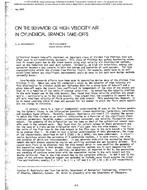
BO-2373 — On the Behavior of High Velocity Air in Cylindrical Branch Take-Offs
Cylindrical branch take-offs represent an important class of divided flow fittings that are often used in air-conditioning ductwork. This class of fittings has gained increasing attention in recent years due to the trend toward using high velocity air distribution systems, such as the induction and dual duct systems. Evidently, at high air velocities, energy conservation becomes a key concern in both the design and operation of such systems. The loss characteristics within the divided flow fitting itself, for example, would have to be well established before any significant improvements could be made to the dust work design methods currently known.
Considerable research efforts have been made in generating design data of the divided flow fittings (1-5). Abbud and Long (6) conducted a study on the behavior of high velocity air flow distribution in circular ducts and indicated that for a given type of take-off and a given take-off angle the branch loss coefficient is independent of the size of the branch and that it is a function of the ratio of average velocities. By measuring the velocity profiles in the main branch and in the side branch, they found that these velocity profiles are unsymmetric- particularly so in the side branch. They argued·that the assymetry is caused by an off-axis resultant velocity of fluid entering the side branch. This explanation, however, is by no means complete since it does not account for the manner in which the fluid would negotiate the change in direction.
Product Details
- Published:
- 1975
- Number of Pages:
- 8
- File Size:
- 1 file , 880 KB
- Product Code(s):
- D-BO-2373
- Note:
- This product is unavailable in Russia, Belarus


